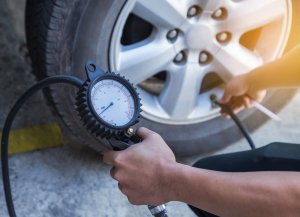If you drive regularly, keeping your car’s tires properly inflated is a critical safety measure. It’s a fact that cars drive better when their tires are properly inflated. Tires with the specified amount of air pressure also last longer and promote better fuel efficiency, sportier handling, and overall safety.
The Dangers of Low Tire Pressure
When your tire pressure is too low, it affects your car’s braking distances, makes your vehicle less responsive, and has a negative impact on handling. While this is dangerous no matter what, it can be especially dangerous when you need to make an emergency stop or conduct an evasive maneuver.
As if that weren’t enough, low tire pressure creates excessive flexion in your side walls. This, in turn, generates heat. While a low level of tire heat just makes your tires wear out earlier than they otherwise would, high levels of heat can create blowouts or a total loss of tread segments on your tire.
Under-inflated tires also don’t roll as easily as properly-inflated tires. This means you’ll be reducing your fuel efficiency if you’re not keeping your tires at the recommended level of pressure. Under-inflated tires will also wear unevenly – wearing down the center of the tread faster than the outer edges and requiring you to replace our tires sooner than you otherwise would.
Ensuring Proper Tire Pressure in Pensacola, FL
The first step in making sure you’re maintaining the correct tire pressure is to take a look at your owner’s manual and maintenance terms. These documents will give you the exact and ideal tire pressure for your vehicle.
If you don’t find it in your owner’s manual, take a look at the inside of your glove box. This is where tire pressure information is typically located in older-model vehicles (those manufactured before 2003).
Keep in mind that you shouldn’t use the tire pressure number molded into the side of your tire wall. This is the pressure level that’s needed to meet your car’s full load-carrying
If you have additional questions regarding your tire pressure, head to your local auto repair shop for some professional input.
5 Smart Tire Inflation Tips
Follow these five tips to ensure you get your tire pressure right, every time:
- Check your tire pressure routinely. As a general rule, you’ll want to check it once a week. If that’s too much for you, at least once a month (and always before an extended drive) will do.
- Use a quality pressure gauge. For best results, seek out dial or digital gauges, which are much more accurate than their less expensive counterparts.
- Check the pressure when your tires are cold. Hot tires will throw off your readings and can lead you to over- or under-inflate your tires.
- Know when to increase tire pressures. If applicable, you’ll want to increase your tire pressure for pulling heavy loads, towing, or driving long distances on the highway.
- Talk to a professional about new tires. Getting new tires on your vehicle may change your pressure ratings, so be sure to ask an expert about this before you drive off.
If you have questions about your tire pressure and how to keep it in a safe, efficient range, contact our team today! We offer full brake and tire services to keep you going down the road as safely as possible!
